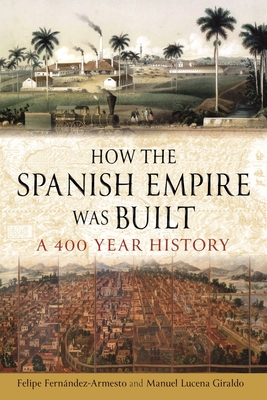You are here
Back to topHow the Spanish Empire Was Built: A 400 Year History (Hardcover)
$40.00
Usually Ships in 1-5 Days
Description
The untold story of the engineering behind the empire, showing how imperial Spain built upon existing infrastructure and hierarchies of the Inca, Aztec, and more, to further its growth.
Sixteenth-century Spain was small, poor, disunited, and sparsely populated. Yet the Spaniards and their allies built the largest empire the world had ever seen. How did they achieve this? Felipe Fernández-Armesto and Manuel Lucena Giraldo argue that Spain’s engineers were critical to this venture. The Spanish invested in infrastructure to the advantage of local power brokers, enhancing the abilities of incumbent elites to grow wealthy on trade, and widening the arc of Spanish influence. Bringing to life stories of engineers, prospectors, soldiers, and priests, the authors paint a vivid portrait of Spanish America in the age of conquest. This is a dazzling new history of the Spanish Empire, and a new understanding of empire itself, as a venture marked as much by collaboration as oppression.
About the Author
Felipe Fernández-Armesto is the William P. Reynolds Professor of History at the University of Notre Dame and an award-winning scholar and historian. His books include Straits.
Manuel Lucena Giraldo is a research scientist at the Spanish National Research Council and an adjunct professor at IE University and ESCP Business School Europe. His books include Firsting in the Early Modern Atlantic World.
Praise For…
"In the Americas, distant colonies were stabilized through key elements of infrastructure such as roads, ports, bridges, fortifications, canals, mills, and dams. Without the forethought of engineers, the authors say, the Spanish colonial efforts would likely have faltered. . . . An engaging new approach to understanding the spread of the Spanish empire. Highly recommended."
— Library Journal
"How the Spanish Empire was Built is extraordinarily learned, and gilded with linguistic flourishes."
— Literary Review
"Be prepared: Fernández-Armesto and Lucena Giraldo will sweep you off the solid ground of what you thought you knew about empire, as they dive beneath the scholarly wave of structuralism to find an infrastructural undertow. But fear not. In the hands of these historical engineers, as witty as they are erudite, this manual for how to make an empire offers an answer to an old question: how on earth did imperialists do it? And their answer is as well designed, built, and fortified as Spain’s colonial enterprise mostly seems to have been."
— Matthew Restall, author of "Seven Myths of the Spanish Conquest" and "When Montezuma Met Cortés"
“’What have the Spaniards ever done for us?’ imperial subjects may have asked, plotting rebellion. ‘Aqueducts?’ One may have ventured. ‘Okay, aqueducts. What else?’ ‘Appeals courts?’ ‘Right! Appeals courts. And?’ ‘Well, the mails?’ ‘Okay. So there are the aqueducts, the appeals courts, the royal mail. But really, what have the Spaniards ever done for us?’ ‘Hospitals?’ ‘The transoceanic fleet system?’ ‘Defensive fortifications?’ ‘Arched bridges?’ ‘A standardized writing system?’ One gets the idea. Certain to spark heated discussions like this one, How the Spanish Empire was Built offers a comprehensive defense of Spanish logistical ingenuity, a neo-Roman project of truly global dimensions. Known mostly to Spanish historians of science and engineering until now, the logistical stuff of empire, what made it function day-by-day for so long despite the tyranny of distance, the temptations of corruption, and the relentless downward tug of entropy, has remained obscure to most Anglophone readers. In an age obsessed with global supply chains, instant communications, and global epidemics, there is much to be learned from predecessors who first encircled the world, for better or worse. The authors say this is simply a book about the ‘scaffolding of empire,’ but it is about much more. It is a provocation.”
— Kris Lane, Tulane University
“An essential book, magisterially written . . . in a limpid, clear style, without sacrificing academic rigour.”
— Fernando R. Lafuente
“[The authors] explore an under-appreciated yet essential dimension of the Spanish Empire: the public works which allowed . . . a small European minority to control, develop and defend a vast territory.”
— Alfonso López
“The authors demonstrate a rare capacity to make accessible a voluminous knowledge of the reality of the overseas territories of the Spanish Monarchy. . . . [This book] should be in the library of every lover of American history.”
— Maria Saavedra
